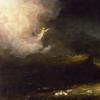'Awaken: A Tibetan Journey Toward Enlightenment' Debuts at VMFA, Travels
- RICHMOND, Virginia
- /
- March 04, 2019
The Virginia Museum of Fine Arts invites visitors to power down, unplug and join a voyage into the visionary art of Tibetan Buddhism in Awaken: A Tibetan Buddhist Journey Toward Enlightenment, on view Apr. 27–Aug. 18, 2019. The journey from clamor to contemplation unfolds as audiences progress through the experiential exhibition to engage with nearly 100 spectacular objects, both historical and contemporary. The exhibition is curated by Dr. John Henry Rice, VMFA’s E. Rhodes and Leona B. Carpenter Curator of South Asian and Islamic Art, and Dr. Jeffrey Durham, Associate Curator of Himalayan Art, Asian Art Museum, San Francisco, each representing one of the country’s most extraordinary museum collections of Himalayan art. Drawn largely from the permanent collections of these two museums, the exhibition features additional works from private collections and institutions including the Rubin Museum of Art, the Newark Museum and the Museum of Fine Arts, Boston.
Art and visuality are central to Tibetan Buddhism. A practitioner’s journey to awareness is, in part, facilitated through visualizations that require models to help them find their way. The fantastic landscapes and beings within those models—sometimes blissful, sometimes terrifying—comprise a dramatic visual repertoire unrivaled in the world of religious art. Awaken is designed as an immersive exhibition that guides its audience along a journey through that visionary topography. The reward is a glimpse into reality’s true nature and a culminating vision of clarity as powerful as the confusion with which the journey began.
“The Virginia Museum of Fine Arts is home to one of the top five Himalayan art collections in the nation,” says VMFA Director Alex Nyerges. “We are thrilled to have the opportunity to share our holdings in such an innovative way, alongside works from the Asian Art Museum and other renowned collections. Through this immersive exhibition, we are once again bringing the world to Virginia, allowing visitors to deepen their understanding of the role played by works of art in Tibetan Buddhist culture and religious practices.”
The exhibition is composed of a series of ten spaces corresponding to the different phases of a journey toward enlightenment. First is a brief introduction, where the basic problem posited by the exhibition—that we are lulled asleep to reality by the world’s daily clamor—is revealed through a gauntlet of modern-day video imagery. As they move through the exhibition, visitors learn some of Buddhism’s essential teachings, are introduced to a “guide” represented by a painting of a 15th-century Tibetan lama, and are given a map in the form of a painted mandala. At the center of the exhibition is a space to rest and contemplate before embarking on the multistage journey into the mandala’s visionary universe and eventually confronting the ultimate ordeal: death itself. Following a glimpse into the true nondual nature of the mind—represented by paired male and female deities—the exhibition concludes in a stark white room, where the visitor “meets” a sublime 12th-century stone sculpture of a crowned Buddha, appearing as a reflection of the visitor who stands before him.
Along with works from as early as the ninth century AD, the exhibition features three paintings by contemporary Nepalese-American artist Tsherin Sherpa, who trained in traditional Tibetan painting with his father, renowned Tibetan painter Master Urgen Dorje Sherpa.
“I’m excited that people will see these objects within the context of this exhibition,” says Rice. “Presenting this art through a narrative that offers the visitor opportunities to be both viewer and participant is a departure from traditional displays of such material and should be a memorable experience. There is also potential in this exhibition for visitors to learn not only about the stunning art of Tibetan Buddhism but also something about themselves.”
From May 2 through May 5, a group of Tibetan Buddhist monks from Drepung Loseling Monastery will create a sand mandala near the exhibition’s entrance, which—in accordance with their beliefs and practice—they will dismantle in a return visit on Aug. 3. Their visit is part of the Mystical Arts of Tibet World Tour that has traveled for more than 25 years and is endorsed by His Holiness the Dalai Lama. The goal of the tour is to share Tibet’s rich, authentic and sacred performing and visual arts with audiences all over the world. On May 2, co-curators Rice and Durham will discuss highlights of Awaken and the collaborative journey they undertook in its creation.
Accompanying the exhibition is an illustrated 252-page catalogue, featuring a principal essay providing an in-depth narrative by co-curators Rice and Durham. Other contributors include noted scholars and experts Elena Pakhoutova, Katherine Anne Paul, Alexander von Rospatt, Eric Huntington and Tsherin Sherpa (with Paul Ferguson), who address several of the exhibition’s themes. The hardcover catalogue can be ordered online (vmfa.museum/shop/) or by contacting the VMFA shop at 804.340.1525.
Awaken will be on view at the Asian Art Museum in San Francisco Jan. 17–Apr. 19, 2020.




10270x400_c.jpg)

















